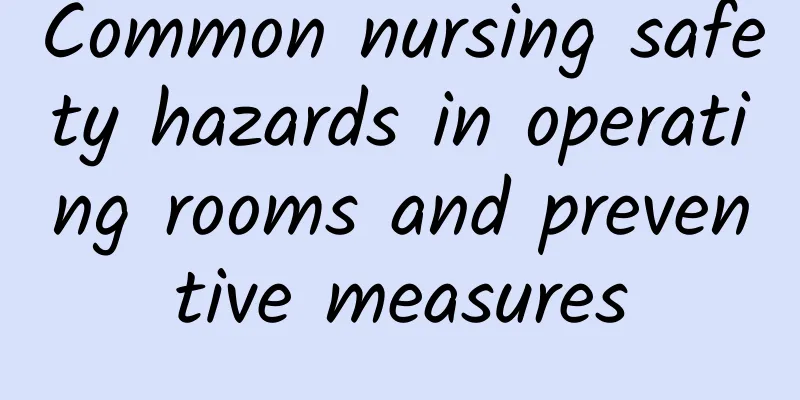Common nursing safety hazards in operating rooms and preventive measures

|
The operating room is one of the most important departments in the hospital, responsible for the treatment of various surgeries. However, due to the complexity and high risk of work in the operating room, there are often various safety hazards in nursing work. These hazards may not only cause physical harm to patients, but also lead to medical disputes and have a negative impact on the reputation of hospitals and medical staff. 1. What are the common safety hazards in operating room nursing work? Common safety hazards in operating room nursing work involve multiple aspects. These hazards may not only pose a threat to patient safety, but also affect the surgical results and the professional reputation of medical staff. First, incomplete systems and poor implementation are a major hidden danger in operating room nursing. The introduction of the new medical accident handling regulations has brought new challenges to operating room nursing, but some hospitals have failed to revise or add relevant systems in a timely manner, resulting in a lack of clear guidance and regulations when dealing with medical accidents. Secondly, technical risks cannot be ignored. Operating room nurses undertake a special task that requires a wide range of knowledge, strong business capabilities and rapid emergency response capabilities. However, with the continuous development of new businesses and new technologies and the extensive application of medical instruments and equipment, the technical risks of operating room nurses are also increasing. If nurses lack a comprehensive understanding of the operation methods and precautions of new medical devices, it may cause accidental injuries to patients during surgery. In addition, environmental factors may also pose safety risks to nursing work in the operating room. The noise sources in the operating room, such as the sound of the suction device, monitor and other equipment, may not only increase the patient's fear and discomfort, but also interfere with the judgment and decision-making of medical staff. At the same time, if the air disinfection in the operating room is not up to standard or there are too many visitors, the risk of incision infection in patients may also increase. 2What preventive measures should be taken to address these safety hazards? In view of the potential safety hazards in operating room nursing work, a series of comprehensive and detailed preventive measures should be taken to ensure the safety of patients and the smooth progress of operations. First, the rules and regulations related to operating room nursing should be improved and ensured to be effectively implemented. This includes the operating room safety management system, checking system, disinfection and isolation system, and item inventory system. Hospitals should review and update these systems regularly to adapt to the continuous advancement of medical technology and the actual situation of the operating room. At the same time, it is necessary to strengthen the system training of medical staff, improve their system awareness and execution, and ensure that every operation complies with the regulations. Second, in terms of technical operation, the professional skills training of operating room nurses should be strengthened. The professional level and emergency response ability of nurses can be improved by holding regular training courses, inviting experts to give lectures, and conducting simulation exercises. In particular, strict pre-job training and assessment should be carried out for new nurses and interns to ensure that they are competent for operating room nursing work. Third, in terms of environmental management, the environmental layout and equipment configuration of the operating room should be optimized. The operating room should be kept clean, quiet, and comfortable, reducing unnecessary noise and interference. At the same time, the air in the operating room should be disinfected and cleaned regularly to ensure that the air cleanliness of the operating room meets the standards. The equipment and instruments in the operating room should be inspected, maintained, and maintained regularly to ensure that they are in good condition. In addition, the number and time of visitors in the operating room should be limited to avoid excessive personnel flow from interfering with the operating room environment. Fourth, in terms of patient transportation and positioning, the patient transportation process should be ensured to be safe and secure. When transporting patients, the patient's identity information and surgical site should be carefully checked to avoid picking up the wrong patient or placing the wrong patient in the operating room. In addition, when positioning the patient, the appropriate position should be selected according to the type of surgery and the patient's physical condition, and auxiliary tools such as decompression pads should be used to avoid complications caused by improper positioning of the patient. During the operation, the patient's vital signs and position changes should be closely monitored, and adjustments and treatments should be made in a timely manner. Fifth, in terms of inventory and medication, the inventory system and medication checking system should be strictly implemented. Before surgery, before and after closing the body cavity, before and after suturing the incision, and other critical moments, the quantity and integrity of surgical instruments, dressings and other items should be carefully counted to ensure that there is no omission or misuse. In summary, in order to prevent safety hazards in operating room nursing work, we should take preventive measures such as establishing and improving rules and regulations, strengthening business training and skills assessment, and optimizing the operating room environment. The implementation of these measures will help improve the quality and efficiency of operating room nursing work, ensure the safety of patients and the smooth progress of surgery. At the same time, it will also help to improve the professional quality and work responsibility of medical staff, and contribute to the healthy development of the medical industry. Author: Zhu Xiuping |
<<: [Medical Q&A] How long does it take for sunscreen to become invalid after it is opened?
>>: [Medical Q&A] Why do menopausal women experience knee pain?
Recommend
Causes of brown vaginal discharge in early pregnancy
Children can be said to be the hope of the mother...
Has anyone cured premature ovarian failure? How to treat it?
When a woman suffers from premature ovarian failu...
Which one is less harmful to the body, surgical abortion or medical abortion?
Both artificial abortion and medical treatment fa...
How to relieve calf pain
Now we have entered autumn, and the temperature d...
What happens if there is a lump inside the cesarean section wound?
Cesarean section, also known as cesarean section,...
Why do women have two periods in one month?
Although having two periods in a month sounds imp...
Causes of yellow vaginal discharge
Yellow vaginal discharge is yellow leucorrhea, wh...
How many times a month does a woman ovulate?
The egg is contained in the female body. After co...
How should women take care of themselves after giving birth?
Giving birth to a child is a particularly harmful...
Can I take medicine for body odor during pregnancy?
If you develop body odor during pregnancy or alre...
Core information on oral health for the elderly on National Love Teeth Day 2023
1. Maintain oral health and promote overall healt...
How to treat multiple uterine fibroids?
Uterine fibroids are a benign tumor that are usua...
What is maternal confinement disease
Postpartum women are a relatively special group, ...









